Statements of Significance
Statements of significance for some of the objects featured in A Place For The Friendless Female: Sydney's Female Immigration Depot.
F I R S T A R R I V A L S
Statement of significance for children and infants' clothing from the Hyde Park Barracks Museum archaeology collection

Photograph Jenni Carter
Infants and children's clothes
This child's cap/bonnet, christening gown section and pair of children's socks were recovered from underfloor deposits on level 3 during archaeological investigation of Hyde Park Barracks Museum from 1979 to 1981. Based on previous analyses, the textiles were deposited after 1848 when the barracks were renovated with new floorboards and ceiling materials to become a reception and labour exchange - the Female Immigration Depot - for 'unprotected female' assisted immigrants.
The cotton hand-sewn cap/bonnet, hand-sewn christening gown section with hand-made lace sleeves and pair of socks are now in the archaeological collection of Hyde Park Barracks Museum. Among the small number of children's clothing recovered during archaeological investigation of the building, these clothes are in excellent condition. The cap/bonnet, christening gown and socks are associated with the Female Immigration Depot (1848-86).
An ex-convict of good conduct and sufficient means could apply to the governor for their family to be given free passage to the colony. Caroline Chisholm, known as 'the emigrant's friend', earned this title for her work with poor migrants to Australia in the 19th century and is considered one of the country's most outstanding historical figures. Chisholm is credited as being particularly influential in reviving a British family reunion scheme, which organised government-assisted or free passage to the colony for many families of ex-convicts between 1847 and 1852. The impoverished families of Irish emancipists dominated the scheme. Retrieved from beneath the barracks floors, these textiles are a poignant reminder of the children who passed through the depot before they were reunited with their families.
Statement of significance for children's toys from the Hyde Park Barracks Museum archaeology collection

Photograph Jenni Carter
Children's toys
This game token with lamb illustration, spinning top, child's tea service fragments, jigsaw puzzle piece, toy figure of man on saddle, toy fruit bowl on pedestal and marbles were recovered from underfloor and underground archaeological deposits on levels 2 and 3 of Hyde Park Barracks and outside the building in the barracks courtyard during an archaeological investigation of Hyde Park Barracks from 1979 to 1981. Based on previous analyses, the items from the underfloor collection were deposited after 1848 when the barracks was renovated with new floorboards and ceiling materials to become the Female Immigration Depot for 'unprotected female' assisted immigrants.
Only a small number of children's toys were recovered during archaeological investigation of the building but are significant and are in excellent condition. The toys are associated with the Female Immigration Depot phase of the barracks (1848-86). These traces of 19th century children's material culture left behind today allow the museum to interpret the presence and experience of children in the Female Immigration Depot prior to family reunion.
D R E S S
Statement of significance for purple paisley skirt length from the Hyde Park Barracks Museum archaeology collection
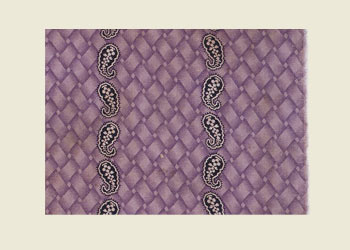
Photograph Jenni Carter
UF5535 - purple paisley skirt lengthThis skirt length was recovered from underfloor deposits during archaeological investigation of Hyde Park Barracks from 1979 to 1981 when renovation and conservation works to the barracks building were carried out. The skirt length was recovered from level 3 of Hyde Park Barracks in the hallway near the south stairwell. Based on previous analyses, the skirt length was deposited after 1848 when the barracks was renovated and new floorboards and ceiling materials were laid in readiness for the barracks becoming the Female Immigration Depot for 'unprotected female' assisted immigrants.
The skirt length is one of many textiles in the archaeology collection recovered from underfloor deposits dating from 1848 - a period associated with one of the female phases of occupation of the building, either as the Female Immigration Depot (1848-86) or when the Hyde Park Asylum for Infirm and Destitute Women (1862-86) occupied the upper floors of the barracks. It is most likely that this skirt length is associated with the Female Immigration Depot as it corresponds to the colours often worn by domestic servants in the 19th century.
The skirt length is cotton printed with a mauve and purple paisley design. Female domestic servants normally worked in printed cotton work dresses or 'wash dresses' that could be washed easily without them shrinking or coming apart. Much of the fabric recovered from beneath the floors at Hyde Park Barracks has been dated to the years of female occupation. It includes countless fragments of mauve floral and paisley printed cotton. Mauve was fashionable in the late 1850s and early 1860s following the discovery in 1856 of the first aniline dye, a synthetic dye derived from coal tar, by English chemist William Perkin. Mauve then became cheap to mass-produce in factories, making it a popular alternative to the plant, animal and mineral dyes that were difficult and expensive to produce.
The skirt length is primarily of historical and aesthetic significance (due to its association with the discovery of the first aniline dyes) with significant social value as representative of late 1850s, early 1860s popular printed cotton fabric worn by working-class women in domestic service. It is in good condition and highlights the presence of women in the Female Immigration Depot and the kind of fabrics they wore, before they found positions as domestic servants in the homes of the middle-class in the colony.
Statement of significance for jewellery from the Hyde Park Barracks Museum archaeology collection
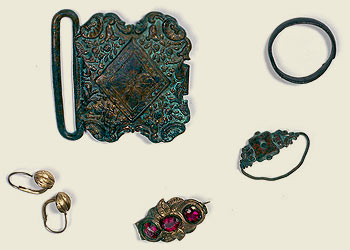
Photograph Jenni Carter
Jewellery
This pair of small, dome-shaped copper alloy earrings, plain flat-band pewter ring, brass decorative brooch, copper alloy ring with pressed decoration and copper alloy belt buckle with pressed decoration and gilding were recovered from underfloor and underground deposits during archaeological investigation of Hyde Park Barracks from 1979 to 1981 when renovation and conservation works to the barracks building were carried out. The jewellery was recovered from level 3 of Hyde Park Barracks and from beneath the ground floor (level 1). Based on previous analyses, the jewellery was deposited after 1848 when the barracks was renovated and new floorboards and ceiling materials were laid in readiness for the barracks becoming a reception and labour exchange - the Female Immigration Depot - for 'unprotected female' assisted immigrants.
The jewellery is therefore thought to be associated with one of the female phases of occupation of the building - either when the barracks was used as the Female Immigration Depot (1848-86), or when the Hyde Park Asylum for Infirm and Destitute Women (1862-86) occupied the building's upper floors. It is most likely that this jewellery is associated with the Female Immigration Depot as pauper women would probably not have brought jewellery with them when entering the asylum.
Working-class women were usually only able to afford metal imitations of more expensive jewellery. However, the fine workmanship of these 'costume' pieces, including ornate decoration and intricate settings, is of aesthetic significance. The jewellery is in good condition following recent specialist conservation treatment and well-provenanced. Its primary social significance, as costume jewellery worn by young working-class women in the 19th century, highlights the presence of women in the Female Immigration Depot before they found positions as domestic servants in the homes of the middle-class in the colony.
I N T H E D E P O T
Statement of significance for religious book from the Hyde Park Barracks Museum archaeology collection

Photograph Jenni Carter
UF2109 - The Economy of Human Life translated from an Indian manuscript written by an ancient Bramin [sic]This book, The economy of human life translated from an Indian manuscript written by an ancient Bramin [sic] , is a fine, well-provenanced example of a common and very popular book of religious instruction fashionable from 1750 to well into the 19th century. The book deals simply and moderately with the rules of life, its ethics and precepts and is one of four religious books of different religions recovered from beneath the barracks floors. It is believed the book was commissioned by a Chinese emperor in the early 18th century who, concerned that ancient manuscripts in the great library in Lhasa, Tibet, were being lost, sent a team of eminent scholars to Tibet to translate forgotten texts into contemporary Chinese. An Englishman living in Peking at the time then translated it into English in 1749. Later attributed to Lord Chesterfield, it is now thought the author of the book was Robert Dodsley, a provincial 18th century bookseller and occasional writer.
This book was recovered from underfloor deposits during archaeological investigation of the building from 1979 to 1981 when renovation and conservation works to the barracks building were carried out. It was recovered from level 3 of Hyde Park Barracks in one of the long dormitories near a doorway. Based on previous analyses, the book was deposited after 1848 when the barracks was renovated and new floorboards and ceiling materials were laid in readiness for the barracks becoming a reception and labour exchange - the Female Immigration Depot - for 'unprotected female' assisted immigrants. Literate immigrant or pauper women would have used this type of book for religious inspiration and instruction.
The book cover is made from good quality calf and the wove paper is in good condition. There are several inscriptions of 'Mary' in a child's handwriting throughout the book. The book is also in very good condition following recent conservation treatment.
It is likely that an immigrant woman brought the book to the colony. The book helps to illustrate the variety of religious texts that were read by occupants of the barracks during the 19th century. This example is significant for being provenanced to a particular building - Hyde Park Barracks - and institution - either the Female Immigration Depot (1848-86) or Hyde Park Asylum for Infirm and Destitute Women (1862-86) which helps the museum to compare and contrast the religious text with others in the collection.
Statement of significance for rosary beads from the Hyde Park Barracks Museum archaeology collection
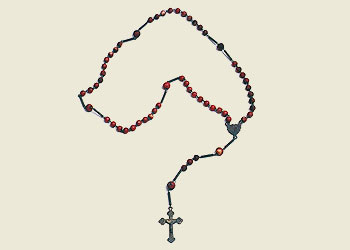
Photograph Jenni Carter
UF62 - a complete set of rosary beadsWhile sections of other rosary beads were recovered during archaeological investigation of Hyde Park Barracks, these rosary beads are the only complete set to be recovered. It is one of a number of several Catholic religious objects held in the archaeology collection and recovered from underfloor deposits dating from 1848, a period associated with one of the female phases of occupation of the building - either when the barracks was used as the Female Immigration Depot (1848-1886) or when the Hyde Park Asylum for Infirm and Destitute Women (1862-1886) occupied the upper floors of the barracks building.
The object is a complete set of rosary beads with 6 large (6.5mm) red painted bone beads and 43 small beads (5mm), joined by a copper alloy link chain. The object has pressed metal Apostles Creed ('O MARIE CONCUE SANS PECHE' (Mary conceived without sin)) and gilt crucifix ('SOUVENIR L'MISSION') with embossed script. Pressed metal bars bridge larger beaded sections.
These rosary beads were recovered from underfloor deposits during archaeological investigation of the building from 1979 to 1981 when renovation and conservation works to the barracks building were carried out. The rosary beads were recovered from level 3 of Hyde Park Barracks in one of the smaller dormitories near a doorway. Based on previous analyses, the rosary beads were deposited after 1848 when the barracks was renovated and new floorboards and ceiling materials were laid in readiness for the barracks becoming the Female Immigration Depot for 'unprotected female' assisted immigrants.
The rosary is the best-known private devotion in the Catholic Church and Christianity's most poplar method of meditation. The use of key prayers, which are repeated with the aid of the string of beads (rosary beads) focuses the meditator. The meditator, further keeps in mind 15 scenes called 'mysteries', all illustrative of the principles of rosary meditation. According to tradition, the devotion of the Rosary was spread by St Dominic in the 13th century, but swept Europe only some 500 years ago.
The rosary beads are an excellent example of an object used in a commonplace Catholic religious ritual. The rosary beads are in very good condition following conservation treatment and are intact. In comparison with other rosary beads, they are well-provenanced dating to the period of female occupation of the barracks from 1848 to 1886. Representing a popular pious object used by all classes, the rosary beads highlight the significant number of particularly Irish Catholics who passed through either the Female Immigration Depot or the Hyde Park Asylum for Infirm and Destitute Women and were visited by the Sisters of Charity.
Statement of significance for religious medal from the Hyde Park Barracks Museum archaeology collection
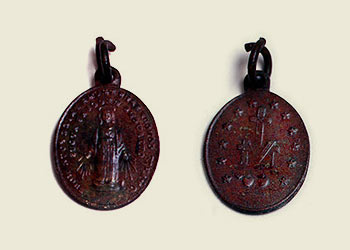
Photograph Jenni Carter
UF10020 - a Catholic religious medalThis religious medal was recovered from underfloor archaeological deposits during archaeological investigation of Hyde Park Barracks from 1979 to 1981. Now held in the archaeological collection of Hyde Park Barracks Museum it is one of several religious medals and other religious objects in the archaeology collection dating from 1848. The medal is thought to be associated with a period when the barracks was occupied by women - either as the Female Immigration Depot (1848-1886) or when the Hyde Park Asylum for Infirm and Destitute Women (1862-1886) occupied the upper floors of the barracks building.
This medal, depicting Christ and Our Lady, is a well-provenanced example of a popular pious object routinely worn around the neck of devout Catholics of all classes. Medals are usually blessed and are thus sacramentals. They are intended to excite devotion and prayer and in general to signify the Christian's commitment to a holy life or their commendation to the particular protection of the subject depicted. They were often given as gifts to the laity.
The medal is a small copper alloy oval object with a ring at the top with an image of the Blessed Mother on the obverse and 'M' of Mary surmounted by the Cross of Christ on the reverse. Obverse: Mary stands with outstretched arms on a globe (the world) crushing the serpent's head (the devil). From her fingers come rays of light symbolic of the blessings and favours which the Blessed Virgin wishes to bestow on her followers. The script in Spanish reads: 'Maria concevid - sin pecado pnega. pornos/ Line 2: que. recurrimos a. vos' (O Mary conceived without sin, pray for us who have recourse to you) surrounds the outer edge of the medal. Reverse: 'M' represents mother, Mary and mediatrix; the cross rises out of the 'M' to represent Jesus who came from Mary. Beneath are two hearts - the heart of the Divine son encircled with thorns and Mary's own heart pierced with the sword of sorrow. Around the edge are 12 stars recalling the vision of St John in the 12 chapters of the Apocalypse or Book of Revelations.
The medal is primarily of historical significance with significant social value and highlights the large number of Irish Catholics who passed through either the Female Immigration Depot or the Hyde Park Asylum for Infirm and Destitute Women and were visited there by the Sisters of Charity.
Statement of significance for religious medal from the Hyde Park Barracks Museum archaeology collection
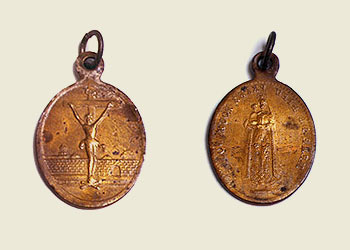
Photograph Jenni Carter
UF17834 - a Catholic religious medalThis medal, depicting Christ and Our Lady is a small copper alloy oval object with a ring at the top with an image of Madonna and child on one side with French script: 'MERE DE DIEU PRIEZ POUR NOUS' (Mother of God pray for us). The crucifixion of Christ outside the walls of Jerusalem in Calvary is depicted on the reverse without text. Conservation treatment has revealed traces of gilding.
Primarily of historic significance with significant social value, the medal highlights the large number of Irish Catholics who passed through either the Female Immigration Depot or the Hyde Park Asylum for Infirm and Destitute Women and were visited there by the Sisters of Charity.
This religious medal was recovered from underfloor deposits during archaeological investigation of Hyde Park Barracks from 1979 to 1981 when renovation and conservation works to the barracks building were carried out.
Statement of significance for hiring room admission pass from the Hyde Park Barracks Museum archaeology collection
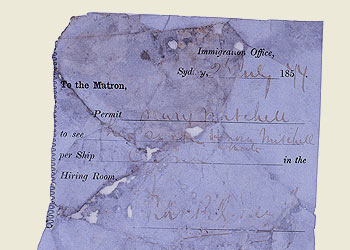
Photograph Jenni Carter
UF4247 - Admission pass to the hiring room of the Female Immigration DepotNow held in the archaeology collection of Hyde Park Barracks Museum, this admission pass to the hiring room of the Female Immigration Depot is the only admission pass recovered from underfloor deposits dating from 1848. The admission pass is associated with the Female Immigration Depot (1848-86) as it permitted Mary Mitchell to enter the hiring room of the depot on 2 July 1877 to see her sister, Hanna Mitchell, who was staying at the depot following her voyage to the colony.
Entry to the Female Immigration Depot hiring room was by prior application to the Agent for Immigration, and only granted to those considered respectable. Prospective employers would apply to the Agent for Immigration for an admission pass in advance of a hiring day (held a few days after the women arrived in Sydney Town) in order to secure the employment of domestic servants.
This admission pass, being in good condition and well-provenanced, is primarily of historical and social significance. Representative of admission passes to the hiring room of the Female Immigration Depot, it highlights the presence of women in the Female Immigration Depot before they found positions as domestic servants in the homes of the middle-class in the colony. While many admission passes to the hiring room of the Female Immigration Depot are held in the collection of State Records New South Wales, this is the only admission pass found in situ at the barracks.
The admission pass was recovered from underfloor deposits during archaeological investigation of Hyde Park Barracks from 1979 to 1981 when renovation and conservation works to the barracks building were carried out. The admission pass was recovered from level 2 of Hyde Park Barracks in one of the large dormitories. Based on previous analyses, the admission pass was deposited after 1848 when the barracks was renovated with new floorboards and ceiling materials to become a reception and labour exchange - the Female Immigration Depot - for 'unprotected female' assisted immigrants.
Statement of significance for sewing tools from the Hyde Park Barracks Museum archaeology collection

Photograph Jenni Carter
Sewing tools
These sewing tools including a wooden tatting shuttle, cotton tatting (a kind of knotted lace netted with a small flat shuttle), ferrous sewing scissors, bone needle case with lid, pinwheel, bone and ferrous bodkin (a small pointed sewing tool used for piercing holes in cloth), ferrous thimble and buttons were recovered from underfloor deposits during archaeological investigation of Hyde Park Barracks from 1979 to 1981 when renovation and conservation works to the barracks building were carried out. The sewing tools were deposited after 1848 when the barracks was renovated.
Many sewing tools including pincushions, bodkins, sewing scissors, knitting needles and countless pins and needles were recovered during archaeological investigation of the barracks. The sewing tools are associated with the female phases of occupation of the building - either when the barracks was used as the Female Immigration Depot (1848-86) or when the Hyde Park Asylum for Infirm and Destitute Women (1862-86) occupied the upper floors of the barracks.
Sewing tools and mended fragments of clothes survive to illustrate the near universal pre-occupation of 19th century women - needlework. Sewing tools recovered from beneath the floors of levels 2 and 3 indicate that sewing by women in the depot and asylum was widespread. While the women waited for hiring day in the Female Immigration Depot they spent their time writing letters, reading, sewing and receiving religious instruction. Women in the Hyde Park Asylum sewed all their own clothes and bed linen and many inmates sewed every day.
The sewing tools are primarily of social significance representing typical sewing tools used by women in the 19th century highlighting the presence of women in the Female Immigration Depot before they found positions as domestic servants in the homes of the middle-class in the colony, or when they lived in the Hyde Park Asylum for Infirm and Destitute Women.
I N T H E C O L O N Y
Statement of significance for apron from the Hyde Park Barracks Museum archaeology collection
Photograph Jenni Carter
UF54 - front-of-house domestic service apronNow held in the archaeological collection of Hyde Park Barracks Museum, the apron is among several recovered from underfloor deposits dating from 1848. Its dating associates it with one of the female phases of occupation of the building - either when the barracks was used as the Female Immigration Depot (1848-86) or during the occupation of the building's upper floors by the Hyde Park Asylum for Infirm and Destitute Women (1862-86). It is most likely that this particular apron is associated with the Female Immigration Depot as it is a front-of-house domestic service apron.
The apron is cotton, woven with alternating areas of plain weave and twill to create a 'stripe' effect, and edged with hand-made cotton lace. The waistband and tie are of the same material. The colour of the fabric and lace may have been white or an off-white/cream colour.
This apron was recovered from underfloor deposits during archaeological investigation of Hyde Park Barracks from 1979 to 1981 when renovation and conservation works to the barracks building were carried out. It was recovered from level 2 of Hyde Park Barracks in one of the smaller dormitories under a window sill. Based on previous analyses, the apron was deposited after 1848 when the barracks was renovated and new floorboards and ceiling materials were laid in readiness for the barracks becoming a reception and labour exchange - the Female Immigration Depot - for 'unprotected female' assisted immigrants.
The apron is primarily of historical and social significance representing the uniform of young front-of-house domestic servants, and highlights the presence of women in the Female Immigration Depot before they found positions as domestic servants in the homes of the middle-class in the colony.

The Migration Heritage Centre at the Powerhouse Museum is a NSW Government initiative supported by the Community Relations Commission. www.migrationheritage.nsw.gov.au




